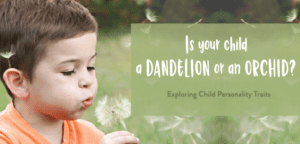
My sons have a lot in common: the same sparkling blue eyes, an obsession with Lightning McQueen and sweet potatoes, and the same birthday. They’re fraternal twins. Even though they were “womb-mates” for nearly 9 months, they couldn’t be more opposite. One is a social butterfly. A laid back, go-with-the-flow kind of guy. The other is shy, “expressive,” wears his emotions on his sleeve, and doesn’t tolerate new situations well.
I often scratch my head wondering why my boys react so differently to the same situation. Then I heard about the Orchid Theory and it all made sense. Walker is hearty like a dandelion- able to adapt and thrive in any situation, while Henry is highly sensitive to his surroundings- with an exaggerated stress response- (read: crying, kicking, screaming) like an orchid.
Orchids and Dandelions
First introduced by Dr. Thomas Boyce and his colleagues in 2005, the Orchid Theory is based on the surprising link between the stress response of children and their developmental potential. Dr. Boyce, a pediatrician, and researcher at the University of California, found children respond to stress in two ways: like dandelions or orchids.
Dandelions are resilient. You’ll find them popping up in the most unusual places: cracks in sidewalks cracks, parking lots… your driveway. The strong, sturdy yellow flower blooms where it’s planted. Likewise, the dandelion child is not greatly affected by his environment or adversity and thrives in virtually any situation.

Orchids are the opposite. Notoriously one of the hardest, yet most beautiful flowers to grow, orchids wilt easily and need more TLC (I still can’t seem to master the “two-ice-cubes-a-week” watering schedule). Similarly, orchid children- about 15-20% of all kids- are highly sensitive to their environment, experiencing the world through enhanced sensory input.
For example, my dandelion child nearly knocks down the door to get into music class, jubilantly jumping around with his peers while my orchid child clings to my shoulder crying uncontrollably.
When I step back and view a recent Kindermusic class through the lens of the Orchid Theory, I now realize Henry wasn’t set up for success: the transition was too abrupt (we were late and rushed into class) and the room was extremely loud and overstimulating. To a shy, sensitive orchid child, I now know this was a recipe for disaster.
Qualities of the “Orchid Child”
- Tends to be shy and introverted
- Withdraws from new situations
- Startles easily to loud sounds
- Sensitive to strong smells or has strong taste aversions
- Easily overwhelmed or overstimulated
Hidden Potential
What’s groundbreaking about the Orchid Theory is that the susceptibility for stress isn’t the end of the story. Previously seen as a problem, extreme sensitivity can be a powerful asset.
Precisely because they are hypersensitive, orchid children are far more responsive to positive, nurturing environments than their dandelion counterparts. The result? They’re healthier, more successful and more advanced developmentally than their easy-going peers.
4 Ways To Help Your Orchid Child Thrive
Simple and actionable, these tools may help you cultivate the potential within your orchid child:
- Rock the Routine.
- Develop a flexible routine or a daily schedule
- Predictability helps sensitive children anticipate what’s up next
- If you don’t want a bad habit to form, don’t repeat it two days in a row
- Aim for More Tranquil Transitions
- Use a transition toy or lovie to comfort your child in new situations
- Give yourself an extra 20-minute “transition buffer”. Rushing in at the last minute doesn’t do your child any favors!
- Anticipate your child’s sensitivity triggers and give him options to cope. Too loud at the ballgame? Pack earplugs or noise-canceling headphones to make the transition easier
- Pick your battles. Getting into the car seat is a non-negotiable while wearing mis-mismatched clothes usually isn’t
- Positive, Empathetic Communication
- Build self-confidence with “you statements”. Rather than saying “I am proud of you” use statements like “You did a really great job painting that picture”
- Acknowledge his big, real feelings with empathy
- Name it to tame it. Naming and discussing fears and obstacles is incredibly helpful for children of all ages (even if they are not talking yet)
- Presence Not Perfection
- Your undivided attention and presence is gold. Put down your phone, charge it in another room during play time so you’re not tempted to scroll.
Let’s view our little’s sensitive personality with hope. Because when you nurture him in a loving, supportive environment he will not just survive but thrive.
If you’d like to dig deeper:
Read: The Orchid and the Dandelion: Why Some Children Struggle and How All Can Thrive by W. Thomas Boyce, MD.
Watch: The Orchid Child and the Science of Kindness Thomas Boyce, MD
Listen: Is Your Child An Orchid Or A Dandelion? Unlocking The Science Of Sensitive Kids: Podcast with Thomas Boyce March 4, 2019










